Achieving Full Participation Through Universal Design. Council of Europe Report
Share on social media
Many Europeans with disabilities are unable to participate in important areas of society, simply because policies and the built environment are not designed to meet their requirements. Moreover, with the number of elderly people rapidly increasing, European societies will have to accommodate more and more disabled citizens in the future. This book invites member states to: promote full participation in community life by ensuring access to all areas of society, including the built environment, transport, products and goods, information, public service, education, employment and health care; implement Universal Design as a strategy to ensure equal and democratic rights in society for all individuals, regardless of age, abilities or cultural background, including persons with disabilities.
 Many Europeans with disabilities are unable to participate in important areas of society, simply because policies and the built environment are not designed to meet their requirements.
Many Europeans with disabilities are unable to participate in important areas of society, simply because policies and the built environment are not designed to meet their requirements.
Moreover, with the number of elderly people rapidly increasing, European societies will have to accommodate more and more disabled citizens in the future.
This book invites member states to: promote full participation in community life by ensuring access to all areas of society, including the built environment, transport, products and goods, information, public service, education, employment and health care; implement Universal Design as a strategy to ensure equal and democratic rights in society for all individuals, regardless of age, abilities or cultural background, including persons with disabilities.
Table of Contents
Executive summary
1. Introduction
1.1. Definition of Universal Design/Design for All
1.2. Accessibility
1.3. Universal Design and assistive technology
1.4. Universal Design as a method
2. European position on Universal Design
2.1. Historical events
2.2. The current situation
3. Recommendations to governments
3.1. Recommendation 1: Adopt and decide
3.2. Recommendation 2: Co-ordinate
3.3. Recommendation 3: Implement
3.4. Recommendation 4: Evaluate
4. Examples of good practice in relation to the Council of Europe Disability Action Plan 2006-2015 and its action lines
4.1. General actions
4.2. Action line 1: Participation in political and public life
4.3. Action line 2: Participation in cultural life
4.4. Action line 3: Information and communication
4.5. Action line 4: Education
4.6. Action line 5: Employment
4.7. Action line 6: The built environment
4.8. Action line 7: Transport
4.9. Action line 8: Community living
4.10. Action line 12: Legal protection
4.11. Action line 14: Research and development
4.12. Action line 15: Awareness raising
Appendix
Order the Report in hard copy or PDF format from the Council of Europe Online Bookshop
